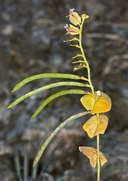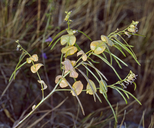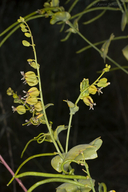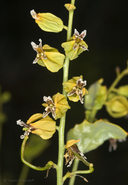notes Habitus shot of a single relatively small plant within the population. My thumbnail is 15 mm long, so this plant measured roughly 21 cm in length. Note the simultaneous presence of both straight and quite curled siliques here.
This photo is from a population found in northern Marin County by Doreen & Vernon Smith. Knowing I'm a streptanthophile, Vernon mentioned the find to me in late-May of 2015 and encouraged me to go see and photograph the plants. Doreen and Vernon first noticed the plants in mid-May of 2012.
The plants in this population are annuals and all had round-to-elongate, clasping, leaves & bracts that aged to deep yellow; and equally deep yellow calyces; as well as a tendency for weak to strongly secund inflorescences. They varied is size from around 10-60 cm high; were branched or not; and had mostly spreading fruits that were straight to slightly arching (though some fruits were very curled into one or more complete loops). The population is in a grassy opening on a somewhat steep south-facing slope on serpentine substrate, surrounded by oak woodland.
Although not previously recorded in Marin County, the overall gestalt is that of Streptanthus tortuosus, and...except for being annuals...that's what they seem to key to in the Jepson eFlora, the FNA key, and the key in R. C. Rollins ''The Cruciferae of Continental North America''. Species descriptions for S. tortuosus can be found at this Jepson eFlora link and this FNA link. But that's not the whole story here!
Low elevation, coastal adjacent Marin County seemed to me a surprising place to find S. tortuosus...which I previously associated with habitats from around 1100' elevation (≈330 m) to alpine in the Sierra Nevada. The CalFlora S. tortuosus page indicates records from throughout the length of the Sierra Nevada, continuing through the southern Cascades into the Klamath Mountains, and southward from there into the high North Coast Ranges...with a few outliers reaching the mountains along the boundary of Sonoma and Napa Counties. There are also records scattered within the Santa Lucia Mountains of Monterey County.
As might be expected from its relatively large range, S. tortuosus is a very polymorphic species and many varieties have been described in the past, though the FNA and TJM2 do not currently recognize any subtaxa here...presumably because editors believed the named varieties grade into one another more-or-less continuously without consistent morphological, geographic, and/or ecological criteria to separate them.
So when Doreen asked me what I thought this might be, I answered that it appeared to be a quite surprising disjunct population of S. tortuosus. Earlier she had asked Dick O'Donnell, who is also a streptanthophile (and who previously published a new species in the genus, S. vernalis), and he too opined that it appeared to be S. tortuosus.
When I enquired with Streptanthus doyen Dean W. Taylor about these plants, he noted that the flowers were distinctly compressed and carinate (i.e. the sepals are strongly 'ribbed' or 'keeled'), but that this...as well as the striking yellow of the sepals...was within the broad variation of S. tortuosus, though he wouldn't feel comfortable giving a species ID for certain without examining specimens.
Shortly thereafter (on June 20) Rob Preston (who wrote his Ph.D. dissertation of S. tortuosus years ago) chanced upon the photos which Vernon and I had recently posted on CalPhotos, and they struck him as quite distinctive. He promptly contacted Vernon, Dean, and I...and the next day went out into the field to examine them. Meanwhile, Vernon sent us all photos taken earlier in the season that showed details of the lower leaves (which had abscised by the time I had photographed the plants). Immediately upon receiving those photos, which showed conspicuous pustulate hairs on the lower leaves, Dean categorically retracted his earlier suggestion of S. tortuosus, which is characterized as entirely glabrous. He also made reference to a recent paper on molecular systematics of Strepthanthus by Ivalu Cacho et al and speculated on possibilities for how this new entity might fit into the cladistic framework presented in that paper.
That night Rob, upon returning from his field trip to see the plants, informed us that he noted the upper filament pairs of the flowers were fused and had small sterile anthers. From this Rob hypothesized the affinities to S. tortuosus were likely more superficial than we had previously supposed...and that the vestiture of the lower leaves & stems, and the fused upper filaments and sterile anthers indicated a stronger connection with the S. glandulosus complex, which is already so well represented in Marin Co. by notable endemics such as S. g. niger, S. g. pulchellus, and S. g. secundus.
Meanwhile, Dean had contacted Nick Jensen of RSABG and Kyle Christie of UC Davis, grad students working on molecular systematics of Streptanthus and colleagues in the line of Ivalu and her associated work, and they indicated their interest and willingness to help do molecular analysis on this interesting new Streptanthus. Ivalu herself also wrote with interest, encouragement, and support.
Finally, it turns out botanist and CalPhotos contributor Aaron Arthur had independently discovered another population of Streptanthus in the same general area (as early as 2011) that is very similar and ''tortuosus-like'' but differs in having purple sepals. Aaron contacted Doreen in late May after he ran into info about her and Vernon's find on her Facebook page. Aaron A. had also seen affinities to S. tortuosus, but noted that the vestiture of his plants didn't fit that taxon. It's not clear to me whether Aaron's plants also have fused upper filament pairs with small sterile anthers, but it seems a likelihood. Aaron A. had inquired with various people about his plants, among them Roger Raiche (who, like Doreen, is a CNPS fellow :-). Like Aaron, Roger thought the plants looked like some sort of intergrade between S. tortuosus and S. glandulosus.
At this point, it's too late in the season to gather more field information on the plants this year, and addressing many questions will have to wait until next year. But the knowledge, skills, and enthusiasm of the many people who've become interested and eager to work on understanding this new taxon is encouraging and exciting! One thing to note, it is apparently a very rare plant, and using care and wisdom in protecting the integrity of the plants and their habitats needs to be a very high priority!
Update 6/12/2019: This species now has an officially published binomial name: Streptanthus anomalus...hooray! :-). Holotype specimen images can be seen here and here. Congratulations to Doreen and Aaron A. for seeing their wonderful finds formally recognized! And heartfelt thanks to all who have helped to sort out various taxonomic and other questions associated with this Streptanthus...and may well continue to address further questions in the future. In particular, special gratitude goes to Rob Preston for sharing his deep knowledge and appreciation for the genus Streptanthus...and for applying his talents, effort, wisdom, and perseverance in putting together an excellent paper and shepherding it through to completion & publication!











